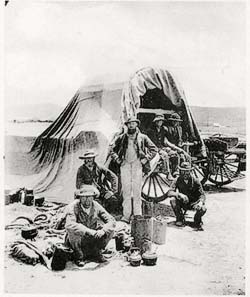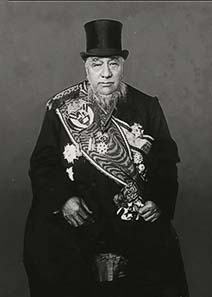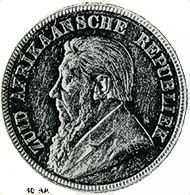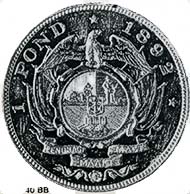By
By courtesy of Barbara Balz / World Money Fair
How the Berlin Mint Came to Produce the First Coins Bearing the Portrait of Ohm Kruger
In 1892 a joke did the rounds in South Africa. Finally the newly minted coins had been put into circulation. They depicted the country’s president, Stephanus Johannes Paulus Kruger, better known as Oom Paul or Ohm Kruger (‘oom’ meaning ‘uncle’ in the Afrikaans language). Kruger was just then running an electoral campaign to be reelected as president. By issuing the coins he had hoped to gain additional support. And now it turned out that some rascal had written the word ‘OS’– which is Afrikaans for ‘bullock’ and ‘blockhead’ – under his image on all these coins. What was the reason for this insult?
The Origins of the Boer Republic
We have to dig deep into the past, to the roots of the Zuid Afrikaansche Republiek and to the Cape of Good Hope, where the Dutch had been settling since the middle of the 17th century. These early colonizers were staunch Calvinists who believed in the divine mission. Convinced that their hard work and material success justified them as God’s beloved children, they felt contempt toward the black people who had lived in that country before them.
According to the Boers, God had created them to serve the whites men. After all, these ‘savages’ made no attempt to adopt their working morale, which proved that they were born to be slaves.
Pic. 1: The Great Trek – Trekboers in front of their wagon. From Wikipedia.
In those times, that was common belief among Europeans. However, in some countries attitudes change (not so much for ethical but rather for economic reasons), which was what happened in Britain. And at the beginning of the 19th century the English took control of the Cape region. The abolition of slavery, together with a general feeling of being exposed to British rule, made many Boers leave the Cape country on the Great Trek, setting out for a promised country far up north.
Among them was ten-year-old Paul Kruger. He owed his name to an ancestor from Berlin who had come to the country as a mercenary of the Dutch East India Company. Apart from that, he was a typical Afrikaner boy who had learned to survive on the fringe of civilization.
Survival not only meant working hard for your daily bread but also involved fighting against the native Ndebele people. Kruger was talented, in that respect. He excelled as an organizer and commander, so that in 1864 he was made General Commander of the Boer troops of the Transvaal Republic, founded in 1839.
Pic. 2: Paul Kruger as President of the South-African Republic, photo taken in 1898.
In 1871, Johannes Nicolaas de Beer discovered a diamond on his farm in Transvaal, which led to the most important diamond rush of all time. The English tried to take possession of the Transvaal in 1877, but were fought back. In 1881 they had to grant independence to Transvaal. Paul Kruger was elected the first president of the new Boer State in 1883 (pic. 2)
Gold at Witwatersrand
By the mid-1890s, the government of the Zuid Afrikaansche Republiek realized they were in possession of huge gold deposits, located in Witwatersrand. This financially enabled President Kruger to initiate the minting of coins. Following his motion, the ‘Volksraad’ passed a law that gave Dutch, German and investors the possibility to found a national bank for the Transvaal. At the same time, it was stipulated that face value, design, metal content and weight of the South-African coins would be similar to English currency. As the country did not have a mint then, it was decided to commission the minting of the first Zuidafrikaansche Pond to Berlin to make sure the coins could be put into circulation before the upcoming presidential elections (pics. 3-5).
Pic. 3: Zuid Afrikaansche Republiek. Paul Kruger, 1883-1902. 1 pond in gold.
Pic. 4: Zuid Afrikaansche Republiek. Paul Kruger, 1883-1902. 2 shilling in silver.
Pic. 5: Zuid Afrikaansche Republiek. Paul Kruger, 1883-1902. 1 penny in bronze.
A Capital Mistake
What had been a good idea in the first place, turned out to be a boomerang. Otto Schultz, die cutter at the Berlin Mint and responsible for designing the coins, made a capital mistake – although without a bad conscience. The craftsman signed his work – Kruger’s image – with his initials O.S. (pics. 6, 8), evidently not knowing that the word ‘os’ means ‘bullock’ or ‘blockhead’ in Afrikaans.
That was certainly not a good electoral propaganda for Ohm Kruger. His opponents took advantage of the German die cutter’s mistake, ridiculing their rival to the point he almost had not been reelected. Before the next issue of the coin, the mistake was corrected and the signature O.S. removed. Only a few collectors’ pieces of the first issue have survived until today.
Incidentally, another erroneous detail was found on the first Krugerpond (pic. 7). Instead of the typical South-African trekker wagon with one pole and much larger back than front wheels, Schultz’ designed a European wagon with double shafts and four wheels of equal size.
Pic. 6: Zuid Afrikaansche Republiek. Paul Kruger, 1883-1902. 1 pond (magnified)
Pic. 7: Detail from the reverse of two 1-pond-coins from 1892 and 1894.
Revived Contact between the Mints of Berlin and South Africa
In 2006, representatives of the Pretoria and the Berlin Mint met in Berlin on the occasion of the World Money Fair. Of course, the subject of their old connection came up. Thus, the idea of minting a Krugerrand in Berlin was born. Distinctive features of the Berlin Krugerrand are the mintmark, the head of the Berlin bear and the logo of the Berlin Mint.
In 2010, the Berlin Krugerrands will be struck once again on the occasion of South Africa being guest of honor of World Money Fair.
In addition, the Berlin Coin Cabinet will exhibit original striking tools of the Berlin mint for South African coins at the World Money Fair. You will see the matrixes of the 5-Shilling pieces. The bad conservation dates back to a bomb hit, which stroke the strong room of the Berlin mint on March 23, 1944. The fire was doused by flooding the safe, which caused the corrosion of the matrixes.
[http://www.smb.museum/ikmk/object.php?id=18217705 and http://www.smb.museum/ikmk/object.php?id=18216332.]
Pic. 08: Krugerrand 2006, minted in Berlin, with Berlin bear mintmark – 2010 this issue will be revived.
The End of the Zuid Afrikaansche Republiek
Back to the gold finds in Witwatersrand in the 1890s, which naturally had revived the English interest in Transvaal. Cecil Rhodes, prime minister of the British Cape Colony since 1890, stirred up the British settlers living in the Zuid Afrikaansche Republiek to stand up against Kruger’s government. To support them, Rhodes sent out an army of 600 men. However, he had overestimated his possibilities – his men were fought back, the rebelling ‘Uitlanders’ (= foreigners) were imprisoned, some killed. Rhodes had to resign as prime minister in 1896.
Unfortunately, the gold finds in Witwatersrand were too important, so England’s greed did not subside so quickly. In 1899, another ultimatum was made to Kruger, this time by the British government, asking him to immediately grant the right to vote to all foreigners living in his republic. Subsequently, Kruger declared war upon Great Britain on October 11, 1899 – a mistake, as would soon become apparent.
This time, the English government mobilized a different set of resources than for Cecil Rhodes’ private feud. Kruger realized he would need help, so he traveled to Europe in 1900 to ask the Netherlands and Germany for support. But neither the Dutch Queen nor the German emperor thought it worthwhile to risk a conflict with England for the cause of the Boers. Kruger gave up hope, in the end. He stayed in Europe and died in exile, in 1902, in the Swiss village of Clarens.
The Boers lost the war against England, but the English had also misjudged the situation. They soon realized that the economy would not recover without the participation of the Boer population. Therefore, a compromise was adopted, granting Afrikaners the same political rights in the newly introduced democracy. Thus, they could take advantage of their superior numbers to shape South Africa’s politics according to their ideas.














